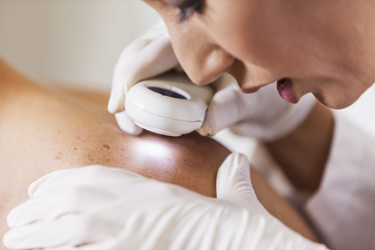Designing A Phase 3 Clinical Trial In Rare Dermatology: Lessons Learned
By Jessica Raiz, MPH, and Alan Mendelsohn, MD, Timber Pharmaceuticals

It has been estimated that the market for pharmaceuticals in the rare dermatology field will see tenfold growth over the next several years.1 Products are in development for dermatologic conditions such as congenital ichthyosis (CI) that cause serious symptoms including limited range of motion, chronic itching and wounds, an inability to sweat normally, risk of infections, impaired eyesight or hearing, and countless other comorbidities, which have a significant impact on patients’ physical and emotional health and quality of life as well as affect their families’ lives. The available off-label oral therapies used for these conditions are often associated with serious systemic toxicity, which limits their viability as a treatment option for conditions that require chronic treatment.
But the good news for patients living with rare dermatologic diseases is that no other field in dermatology – even psoriasis, atopic dermatitis, acne or skin cancers – is expected to grow at this rapid rate in terms of research and development efforts. At Timber, we are committed to expanding treatment options in this sector to help patients and families, starting with our approach to treatment of CI, a group of rare genetic keratinization disorders that lead to dry, thickened, and scaling skin.
As rare disease drug developers know, there are unique challenges associated with conducting clinical trials to evaluate potential new treatments for small patient populations with orphan diseases. It can be difficult to find eligible patients to enroll and there is often limited research that can serve as a predicate for trial design, as many studies in the rare disease sector are first of their kind. When we set out to design our pivotal Phase 3 ASCEND study for our lead product candidate, TMB-001 (0.05% topical isotretinoin), for the treatment of moderate to severe X-linked or autosomal recessive CI, we were prepared to address these challenges and apply our lessons learned from earlier stage research, including our experience in designing the Phase 2b CONTROL study.
Even before the data readout from our Phase 2b CONTROL study, we began formulating several possible Phase 3 trial designs and asked scientific, operational, and regulatory questions such as: Do we want to design an open label trial? Or vehicle controlled? Will we need one trial or multiple trials for regulatory approval? What will be the endpoints? In the Phase 2b CONTROL study, we evaluated two doses of TMB-001; for the Phase 3 study, do we want to study one dose or two? What trial design will be feasible? What are the regulatory filing expectations that may need to be fulfilled and how can they be incorporated into the study? In trying to answer these questions, we found that there are two key lessons when designing clinical trials in rare dermatology: listen to different stakeholder audiences, especially patients, and listen to your data.
The Importance Of Listening To Stakeholders
Efforts to identify and align on the pivotal Phase 3 ASCEND study design involved engagement with a range of different stakeholder audiences, including global clinicians, regulatory agencies, ethics committees, patient advocacy groups, and patients. Their partnership and insights on our proposed trial designs were crucial.
Following these discussions, we quickly recognized that the trial designs we preferred might be different from what we could actualize, which in turn might differ from what subjects would be willing to accept in a clinical trial. In just one example, the Phase 3 ASCEND study which will enroll 142 subjects in total will assess the pharmacokinetics of TMB-001 in a subset of 32 subjects, which will require frequent blood draws that can be intrusive for patients in terms of lifestyle, work, parenting, and other areas of life. Subjects typically travel to a clinical trial or research site for blood testing as often as every few days for about two weeks, which some might not be willing or able to do. To minimize the impact on patients’ lives, we partnered with a third-party vendor that will go to patients’ homes or workplaces to perform blood draws to accommodate subjects’ schedules.
Travel burden is also often an issue that we hear from many subjects participating in clinical trials. Our solution was to choose Phase 3 trial site locations in the U.S., Canada, and Europe that would likely be convenient for most participants. Many participants and families will not have to travel via train, car, or airplane for longer than 2 hours to reach a trial site. If travel becomes too onerous during the study, we will implement telehealth visits when necessary. Any remote visits can be managed through a phone app for which we partnered with an organization that offers e-consent forms, e-diaries, and telehealth visits. With the app, subjects can also schedule appointments, get alerts, conduct video conferences with trial investigators, record any discussions, and even send photographs of their skin for evaluation. Our goal is to streamline trial participation as much as possible for subjects and relieve any potential burdens.
In another example, one of the eligibility criteria for the Phase 3 ASCEND study is genetic confirmation of CI, but many patients in the U.S. have never been genetically tested for subtypes of ichthyosis. We identified a genetics lab using test kits that could be sent directly to participants’ homes, allowing them to perform this genetic test themselves without having to travel to a trial site, potentially hundreds of miles away. After completing an electronic informed consent form, the kits (which involve a simple cheek swab) can be sent to the participant and returned using a prepaid FedEx shipping label, minimizing their time commitment.
The Importance Of Listening To Data
Listening to or closely assessing clinical data is also essential when designing follow-on trials in the rare disease space, particularly when compared with more common disease trials. In our Phase 2b CONTROL study, the primary endpoint was the reduction of targeted ichthyosis severity, determined by a 50% or greater reduction in the validated Visual Index for Ichthyosis Severity (VIIS) scaling score (or VIIS-50), a novel scale that garnered positive attention in the CI community. The FDA encouraged us to correlate the VIIS score with the Investigator's Global Assessment (IGA) scale, which is well-known and widely used in clinical research in dermatology. Secondary endpoints in the Phase 2b CONTROL study included reduction in overall ichthyosis severity as measured by a 2-point improvement using the IGA scale (IGA ≥2-grade).
While both scales were considered clinically relevant and provided the information we needed to support future development, we found that the IGA scale was more useful when measuring symptom improvement in patients receiving treatment versus vehicle, compared to the VIIS scale. Based on these learnings, in the Phase 3 study the primary endpoint will be measured by the IGA scale whereas the secondary endpoint will be measured by the VIIS scale.
In addition, when talking to subjects in the Phase 2b CONTROL study we learned that most felt like they had a better quality of life with as little as a 1-point improvement in IGA scale score. One study participant did not meet the primary VIIS-50 endpoint but was ecstatic about his results, primarily relief of scaling and itching on his feet, because it meant he could wear sneakers and play basketball again without discomfort. In listening to patients’ responses, we designed the Phase 3 ASCEND trial to make the endpoint for continuation into the maintenance phase or an adequate response to vehicle a 1-point improvement in IGA scale score.
Results from the Phase 2b CONTROL study also demonstrated a well-known observation that there is a sensitization period in the first few weeks when subjects receive retinoid treatments that we accounted for in the Phase 3 ASCEND study. Given that TMB-001 is a formulation of isotretinoin, a potent retinoid, it is common to see local skin reactions with first use, including stinging, burning, and itching. We also noted, however, that as the Phase 2b study progressed, skin reactions lessened in severity and frequency beyond the first two to four weeks. To minimize the initial sensitization period, we designed the Phase 3 ASCEND study to start with a three-week once-a-day induction period. After the first three weeks, the dosing frequency in the next nine-week treatment period will increase to twice-a-day. At week 12, eligible subjects in the TMB-001 treatment group will be randomized (1:1 ratio) to an open-label treatment with TMB-001 0.05% once or twice daily based on their IGA scores. By reducing the initial sensitization period, we are hopeful that TMB-001 will be better tolerated in most patients, minimizing the need for any potential drug discontinuations.
Recommendations
Particularly in the rare dermatology disease space, it is important not to begin trial design processes with any preconceived notions. There are a range of factors and perspectives to consider that will often impact initial plans. Decision-making should primarily be driven by patient and investigator opinions, as they are ultimately the users of the therapies. It is also essential to make trial participation as easy as possible to encourage enrollment, especially considering the small pools of rare disease patients who are eligible and the logistical burdens that may fall on parents and families.
Close collaboration with global regulatory agencies can provide important insights that inform trial design and position drug developers to be successful in different markets. Understand that not all regulatory agencies will require the same clinical data to support product approval. We have continued to work with the FDA closely throughout the TMB-001 development program and their guidance has been vital to get us to where we are today. They are helpful and hold us accountable, with the same universal goal of helping patients in the U.S. gain access to much needed new treatments.
There is beauty and headache in the field of rare diseases. Many new therapies in development are potential firsts to market and do not have precedents for trial designs, including which study endpoints to evaluate. Rare disease drug developers tread a path as best they can, incorporating any learnings or best practices along the way, and hope that the choices they make are viewed positively by regulators and the patients and medical professionals at the time of potential new drug applications.
References
- Senior, M. & Hadjivasiliou, A. (April 2022). Orphan Drug Report 2022. Evaluate. https://info.evaluate.com/rs/607-YGS-364/images/Evaluate%20Orphan%20Drug%20Report.pdf
About The Authors:
 Jessica Raiz, MPH, is vice president, program management and clinical operations at Timber Pharmaceuticals. She was previously director of clinical operations at Ferring Pharmaceuticals, director of clinical operations at Champions Oncology, Inc., and associate clinical project management director at IQVIA. She also previously held increasing roles of responsibility at Novartis, most recently as U.S. clinical operations team lead. She earned her MPH degree in health law and bioethics from Boston University School of Medicine and her BA degree in biology from Drew University.
Jessica Raiz, MPH, is vice president, program management and clinical operations at Timber Pharmaceuticals. She was previously director of clinical operations at Ferring Pharmaceuticals, director of clinical operations at Champions Oncology, Inc., and associate clinical project management director at IQVIA. She also previously held increasing roles of responsibility at Novartis, most recently as U.S. clinical operations team lead. She earned her MPH degree in health law and bioethics from Boston University School of Medicine and her BA degree in biology from Drew University.
 Alan Mendelsohn, MD, is chief medical officer and executive vice president at Timber Pharmaceuticals and is board certified in pediatrics and pediatric cardiology. He was previously associate vice president of dermatology medical affairs at Sun Pharma where he focused on the post-clinical development of tildrakizumab (ILUMYA), an IL-23p19 inhibitor for patients with moderate to severe plaque psoriasis. Dr. Mendelsohn also has experience as senior director, rheumatology team leader, U.S. Medical Affairs at Pfizer and as senior director of immunology R&D at Johnson & Johnson/Janssen. Dr. Mendelsohn has authored or co-authored more than 200 peer-reviewed abstracts and manuscripts in the areas of dermatology, rheumatology, and cardiology.
Alan Mendelsohn, MD, is chief medical officer and executive vice president at Timber Pharmaceuticals and is board certified in pediatrics and pediatric cardiology. He was previously associate vice president of dermatology medical affairs at Sun Pharma where he focused on the post-clinical development of tildrakizumab (ILUMYA), an IL-23p19 inhibitor for patients with moderate to severe plaque psoriasis. Dr. Mendelsohn also has experience as senior director, rheumatology team leader, U.S. Medical Affairs at Pfizer and as senior director of immunology R&D at Johnson & Johnson/Janssen. Dr. Mendelsohn has authored or co-authored more than 200 peer-reviewed abstracts and manuscripts in the areas of dermatology, rheumatology, and cardiology.
